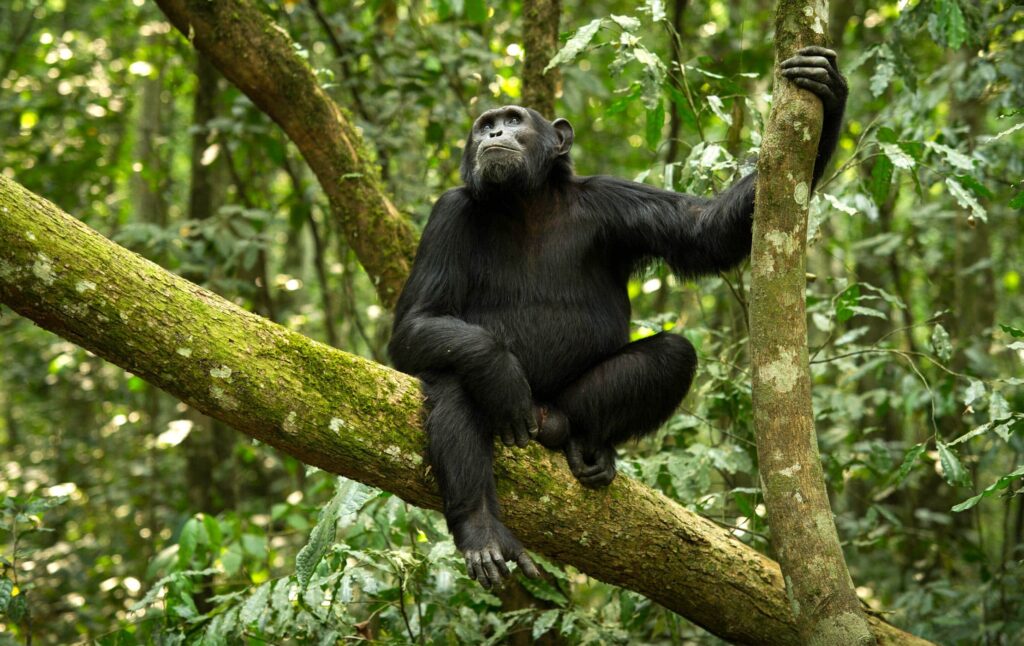Mahale National Park
Mahale National Park, frequently described as “one of the most exquisite parks in Africa,” is situated in the Uvinza District of the Kigoma Region in western Tanzania. The park is situated on the eastern banks of Lake Tanganyika, which delineates Tanzania from the Democratic Republic of the Congo. The protected region encompasses more than 1650 square kilometers. Mahale National Park was founded in 1979 as a wildlife research station and subsequently changed into a national park in 1985 following the relocation of the original population. The initial settlers were the Batongwe and Holoholo tribes. They were expelled from the park and now reside at its periphery. Mahale National Park possesses various distinctive features; specifically, access is exclusively by boat, and exploration is conducted on foot. The protected area is the sole location where chimpanzees and lions coexist.
Vegetation in Mahale National Park
Mahale National Park is distinguished by a variety of flora types, ranging from deep tropical rainforests to miombo woodlands and lowland forests. The lowland regions of Mahale are adorned with verdant tropical rainforests. The woodlands are primarily evergreen, offering a dense canopy that protects several park creatures. The elevated slopes of the Mahale Mountains exhibit a transition to miombo woods in their vegetation. The Miombo forests are characterized by the predominance of trees from the Brachystegia and Julbernardia genera. These woodlands are better suited to an arid climate and undergo a pronounced wet and dry season. In the dry season, numerous trees lose their foliage, however in the wet season, they flourish with verdancy. Miombo forests sustain diverse biodiversity, encompassing tiny animals, reptiles, and avifauna, while serving as a crucial buffer zone for the park’s central rainforest regions.

Montane forests predominate in mountainous places. These forests, suited to colder, temperate conditions, comprise a variety of tree species that flourish in the damp, elevated climate. Bamboo thickets are common in patches at elevated altitudes and around rivers and streams. Bamboo serves as a crucial food source for certain animals in the park. The riparian forests along lakes, rivers, and streams sustain flora such as palms and papyrus. These forests are crucial for a diverse array of animals, including birds, amphibians, and small mammals. They also offer essential pathways for species traversing between various areas inside the park. Wetlands are located in the park’s underlying regions.
Wildlife in Mahale National Park
Mahale National Park is recognized for hosting eastern chimpanzees and nine additional primate species. Included among these primates are blue monkeys, pied colobus, vervet monkeys, red colobus, yellow baboons, and Galago species. Additional animals comprise roan antelope, bushbucks, waterbucks, elephants, and buffaloes. The park hosts 337 bird species, the majority of which are indigenous to the Albertine Rift, including Pel’s fishing owl and Ross’s Turaco.
Activities in Mahale National Park
Chimpanzees
The most prevalent activity conducted at Mahale National Park is this. Tourists venture into the forest in pursuit of these beings. Chimpanzee trekking commences with a training on the rules and regulations pertaining to the activity at the park headquarters. Following the briefing, you will be assigned to the chimpanzee family for trekking, accompanied by a park ranger who will navigate you through the forest. The hike requires 1 to 3 hours. During the journey, you will encounter several primates, including blue monkeys, pied colobus, vervet monkeys, red colobus, and yellow baboons. Upon locating the chimpanzees, you will be permitted to spend one hour with them.
Heritage excursions
Tanzania is recognized for its diverse traditions and customs among numerous ethnic groupings. Encounter the Batongwe and Holoholo tribes at Mahale Mountains National Park. The Holoholo people inhabit the Kigoma and Rukwa regions. The Tongwe people are native to the Mahale Mountains region. Visitors can investigate traditional village life, gaining insights into their practices, beliefs, and lifestyles. This also provides tourists the chance to engage in traditional activities, like craft making, basket weaving, and conventional fishing techniques employed on Lake Tanganyika. Kigoma’s capital should not be overlooked due to its historical significance. The city served as a center for the slave and ivory trade in East Africa during the 19th century. It is also the location where Stanley discovered the supposed missing Dr. Livingstone in Africa in the late 1800s.
Bird observation in Mahale National Park
Mahale National Park hosts 350 avian species, including forest-dwelling birds. Included among these avian species are Russ’s turaco, huge kingfisher, African fish eagle, Pel’s fishing owl, and crested guineafowl. Birdwatching in Mahale National Park is optimal between November and April. This period facilitates the observation of resident birds in their breeding plumage alongside migratory species from different regions of Africa and Europe.
Hiking the Mahale Mountains
Mount Nkungwe is the pinnacle of the Mahale Mountains, reaching an elevation of 2,462 meters. Hiking can be organized for two days ascending and one day descending, with camping at an intermediate location and again at the summit. To ensure the safety of the hikers, armed ranger guides are assigned to accompany the party. When trekking, it is imperative to transport your own camping provisions or equipment.
How to get to Mahale National Park
Mahle Mountains National Park is accessible by road, air, and water. The park is remote by road, and the roads are challenging and difficult during the rainy season. The journey from Arusha to Kigoma takes 2 to 3 days by car, followed by a boat ride to the park. Travelers can access the park via domestic scheduled or chartered flights from Kigoma, Arusha, Mwanza, and Dar es Salaam, which take 5 to 6 hours to reach Mahale Airstrip. Flight activity is heightened during peak seasons from June to October, whereas off-peak periods exhibit reduced frequency. The park is accessible by sea; guests may utilize speedboats that take 4 to 5 hours to arrive at the park. Timber vessels and the sizable steamer from Kigoma are also utilized. The ferry operates biweekly and has a duration of 10 hours per trip.
